Customer Experience Specialist
Quick guide to a successful email strategy
Customer Experience Specialist
We recently updated this still very actual article. Enjoy the read!
Did you know people receive 121 emails a day on average? Some of them get read, some get discarded into people’s spam folder or junk mail. How many are actually valuable?
The goal of this blog post is to show that email marketing is still a sound practice and represents a higher potential return on investment if accompanied by a well-thought-out strategy that considers users’ needs.
Email: A powerful tool
A large majority of the population has an active email address, and 293.6 billion emails are sent and received every day. To what extent should marketers be using this tool?
Three big myths on using email
1. “Email is old tech to today’s young people.”
Text messaging and other instant messaging channels (like the chatbot Bardagi Real Estate developed with us) are very popular amongst Millennials. That said, when it comes to being contacted by brands, email is still the preferred option by all age groups, Millennials included. In fact, according to a 2019 study by Adestra, 77.8 percent of people 19–34 state they prefer being contacted by email.
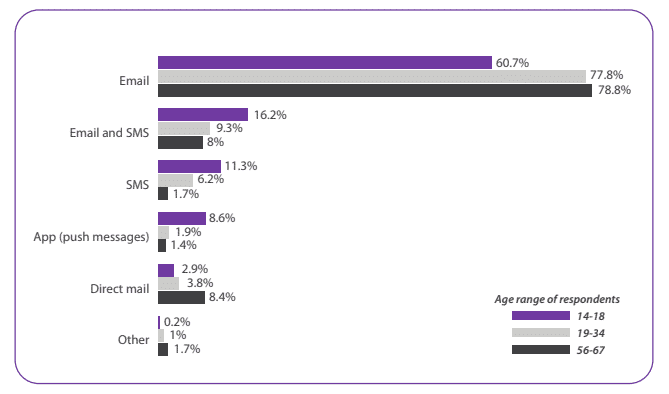
2. “People don’t want to receive promotional emails from brands.”
On the contrary, today email is still consumers’ preferred tool for being contacted by brands: It’s less intrusive than a phone call, mobile notification, or text message while still being accessible at all times. However, users are becoming increasingly demanding and expect to receive a personalized experience. This article from my colleague Edouard does a great job of explaining the importance of this kind of customer experience and offers solutions for effectively personalizing your communications. Basically, the more interesting and relevant the content is, the more recipients will remain subscribers and read your emails attentively.
3. “Frequent emailing irritates people.”
Yes and no. In fact, it depends a lot on the industry, the content sent, and above all the recipient. Ideally you should test what works best for your business and, if your database is large enough, segment your audience by sending fewer or more emails depending on the frequency selected by the recipient. During your testing, in addition to evaluating the number of people who unsubscribe, it’s informative to calculate the average number of subscribers depending on whether your increase or lower your frequency. Several studies have demonstrated that these results will be highly unique to a particular brand and the behaviour of its consumers. It’s therefore important to find the frequency that’s appropriate for your brand. Sometimes doubling the frequency will clearly increase your sales even if the number of people who unsubscribe increases. There are a few content strategies that can mitigate these lost subscriptions.
Users read their email from mobile devices
According to statistics, 61.9 percent of emails are opened on mobile and 81 percent of users 18–24 use their mobile device to open their email.
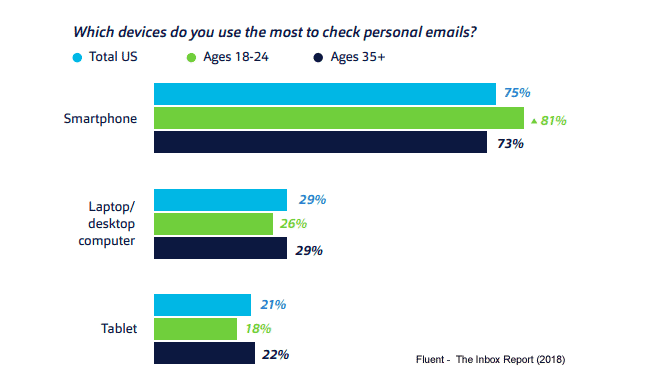
It’s therefore mandatory to format your emails for mobile. Most email marketing platforms already have templates adapted for every screen size that enable previews to be generated depending on the user’s device. Finally, you can also send test emails that you can open on your own mobile devices in order to see how they appear
Conversions: Email marketing is effective!
Email can be used to maintain a relationship with your prospects (lead nurturing) and support new customer acquisition. It’s also a good way of retaining users and increasing your customers’ value by offering products that complement their past purchases.
Email marketing is still the best channel for generating B2B revenue according to U.S. marketing professionals in 2018.
According to a Hubspot study in 2019, 73 percent of Millennials prefer receiving promotions or brand content by email. Several tactics for increasing the number of purchases after the reception of an email can be tested: email with a promotion, emailing a reminder after a shopping cart is abandoned, presenting a new product, etc.
8 best practices for maximizing your strategy
1. Send the right message to the right person using the right tone at the right time
This involves identifying points of contact, key communication moments for your profiles, and the message that should be sent to each one.
- Think about the following moments: creating an account, a purchase, downloading a white paper (B2B), for example.
- Automating your marketing enables you to send a portion of your messages automatically and using personalization.
- Draft your email subject line so it’s clear and to the point and provides a good overview of the content.
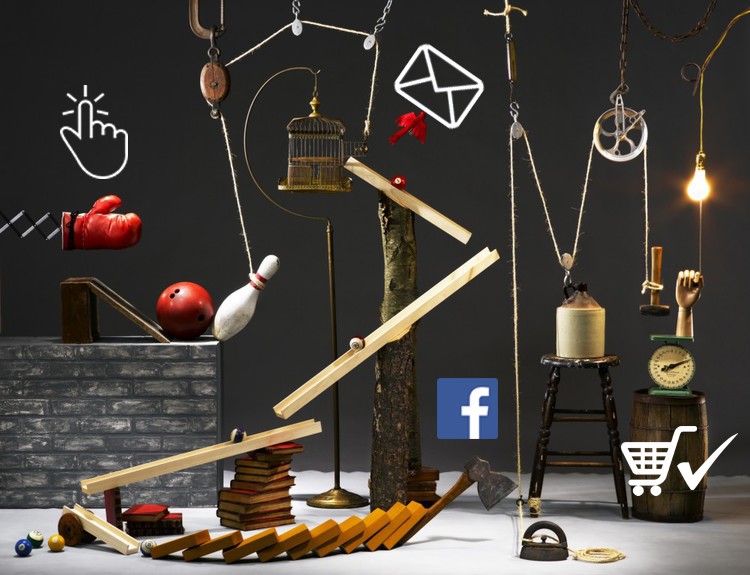
Source: The Maker Mills / Pictos by Adviso
2. Ensure you create added value for your subscribers
If you provide interesting content while offering incentives to your readers, they’ll be much more likely to read your email!
- Be original—make sure your communications stand apart from other promotional emails.
- Send subscribers useful content: advice, answers to consumers’ questions, etc.
- Introduce unique content to your emails that they can’t find on your website: a preview of a new product, exclusive news, a curated selection of content that is useful to the sector (even if it comes from third-party sources).
- Depending on your marketing objectives, you might want recipients to do something after receiving your email, such as download a document, subscribe to an event, click on content, etc. To accomplish this, work on your landing pages where your reader will arrive after clicking on the link in the email:
- Presenting structured content that is both easy to read and useful is a winning formula.
- For event registrations, the email should be as short as possible and contain all the information on the event (time, price, theme, your pitch to encourage registration, etc.).
- For content downloads, like white papers for example, the landing page should be clear and the form they need to fill out should be easily understandable and adapted to the type of content you are providing. Try to find a good balance between the information you are asking for and the value of the download.
- The email’s format should be adapted to mobile. (Have we mentioned yet that users read their email on mobile devices? 🙂)
- Avinash Kaushik’s newsletter The Marketing Analytics Intersect is a leader in the web analytics sector and is particularly successful: It contains unique, useful content for web analysts, is easy to read, provides concrete examples, and is written as a kind of conversation between the reader and the blogger.
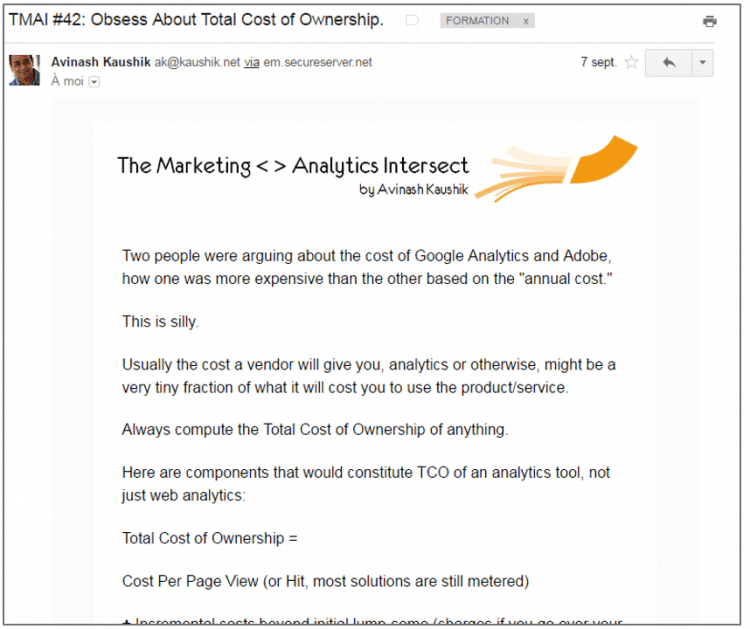 Source: The Marketing Analytics Intersect Email
Source: The Marketing Analytics Intersect Email3. Track your audience and their activity
Before segmenting and personalizing, it’s essential to understand your audience in order to categorize it by profile. To achieve this, introduce tags in order to track your audience on your website and their activities after receiving an email:
- Link your site and your email communication platform: Add a tag from your email platform to pages on your website in order to capture certain interactions. For example, if you notice that part of your audience is consulting blog pages on a certain theme, you can send an email with complementary content featuring this theme to your subscribers.
- Link your email platform to your measuring tool: Add UTM tags so you can use your measurement tool to identify visits and activities after the reception of an email.
- If users are able to create an account on your site, you can link your email tool to your database of accounts: The goal here is to identify subscribers and ensure your communications with them are appropriate. The ideal is still, however, to have an overall view of your consumers’ data.
With these tips, you can better understand, and therefore better respond to, your consumers’ needs while optimizing your marketing initiatives.
4. Segment your email lists
- MailChimp performed a study on the effect of using segmentation on email marketing metrics such as open rate, click rates, etc. The results speak for themselves: For example, a campaign segmented by user interest obtained a click rate on its content that was 80 percent higher than for unsegmented emails.
- Segmentation can notably be done according to the stage of the user in their purchase journey or even by their lead score, both of which can be determined through their interactions with your site or by sending an email enabling you to determine more information about their behaviour.
- Segmentation can also be done by audience expectation, such as preferred frequency of communication or preferred content, for example.
5. Personalize your email communications as much as possible
- Automate your marketing according to your segmentation by sending complementary information related to interactions with your site. For example, offer complementary content following the download of a white paper, or offer a product that complements something recently purchased.
- Reconnect with visitors who have abandoned a shopping cart by offering a limited-time promotion.
- Contact your customers on their birthday and give them a specific offer. As revealed by a Campaign Monitor study, these emails are much more likely to generate transactions.
6. Test
Once again, the magic of the web lies in the possibility of testing and optimizing, so don’t hesitate to test your email campaigns using A/B tests or trial runs and adapt your strategies depending on your results. Transmission times, email frequency, subject lines, content… Everything is testable and measurable!
7. If there’s no yes, that means no
- Since 2014, it’s been illegal to send email communications without having the explicit consent of recipients. For more information on the legal framework, visit this site dedicated to Canada’s anti-spam legislation. Unqualified contacts will only waste your time and money. Focus on the contacts that are engaged and interested in what you have to offer!
- Always include an opt-in option on your forms (contact, download, etc.) and take advantage of it to offer a subscription to your newsletter!
8. Create a fluid communication experience across many points of contact with your customers
Email is a way of communicating with your audience that can (and must) connect with your other owned, earned, and paid media platforms.
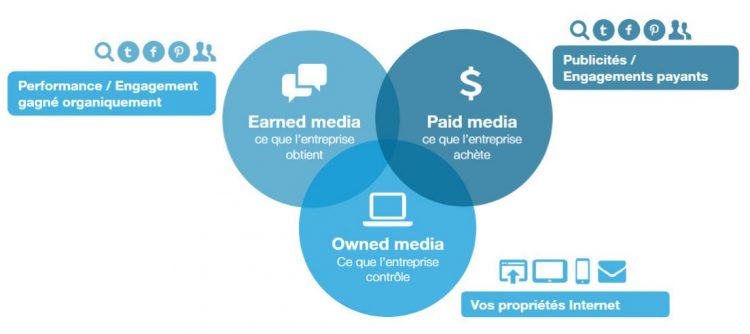
Source: Adviso
Today, marketing automation tools enable you to create a communication flow using several platforms: email, text, mobile device notifications, social media, etc. You can also connect your email or automated marketing tool to your CRM so that your customer service and sales teams know what communication is sent when. If you’re using an email tool that’s not connected with your CRM, be sure to link them so you can unify your data and get a unique perspective on your customers, thereby optimizing your marketing/business initiatives and internal processes. You can also adapt your mass media campaigns using the email addresses in your database. The purpose of all of this is to be able to speak coherently on every platform and become more effective and relevant.
 Source: Wikipedia Orchestra / pictos added by Adviso
Source: Wikipedia Orchestra / pictos added by AdvisoNow go for it!
This article contains a huge amount of relevant information for improving your email strategy. We’ve created a checklist in order to simplify things when it comes time for you to put it all into action. Why wait for tomorrow when you can get started today?
%20(1)-1.jpg)












